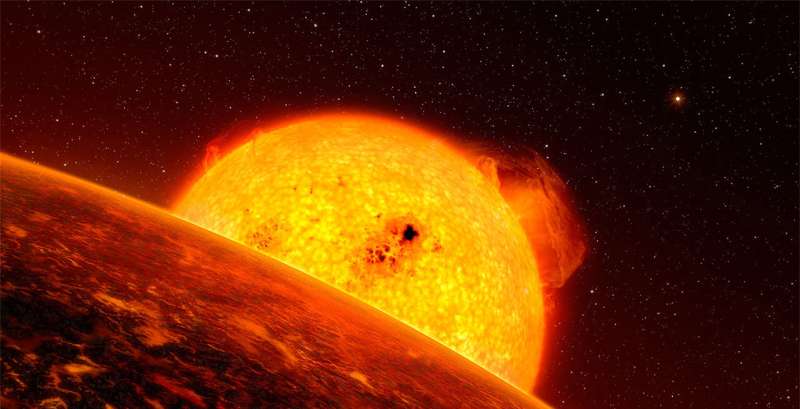An artist's conception of star scorching its nearby exoplanet. New research shows that aging red giant stars, far from destroying life, could warm frozen worlds into habitable homes. Credit: ESO/L. Calçada
In the past 30 years, more than 5,000 planets have been discovered outside our solar system. One common exoplanet is the lava world, a hot super-Earth with oceans of liquid lava. Mantas Zilinskas developed models to simulate possible atmospheres of these worlds. Those simulations provide guidance for astronomers searching for these atmospheres with the James Webb Space Telescope. Zilinskas will receive his Ph.D. on Wednesday, May 24.
Most of the exoplanets observed do not resemble the eight plants in our solar system. For example, there are hot Jupiters, gas giants that are closer to their parent star than Mercury is to the sun, and rostral lava worlds, which are larger than Earth and orbit their parent star so closely that lava oceans flow.
We know little about these distant worlds, says Mantas Zilinskas. Some features astronomers can estimate based on mass, radius and distance from the parent star. But that does not give a complete picture. To find out more about their atmospheres, astronomers therefore use spectroscopy. In this, they measure the light from the parent star that shines through the exoplanet's atmosphere and then traveled to Earth. The molecules and atoms present in an atmosphere absorb unique colors of light. This creates a unique fingerprint for each exoplanet by which you can tell what substances its atmosphere contains.
But deriving the properties from spectroscopy observations is not easy. That is why theoretical astrophysicists like Zilinskas create mathematical models that predict how certain properties translate into observations. "I calculate what astronomers might observe," he explains. "The purpose of my simulations is to tell astronomers what to look for and what that can tell them about exoplanets."
Zilinskas focused his Ph.D. research on atmospheres of lava worlds and their observation with the James Webb Space Telescope launched in late 2021. "These atmospheres have not yet been detected, but we think they exist. Indeed, silicate-rich gases can evaporate from lava oceans to form a thin, tenuous atmosphere," he says. "We are trying to use models to predict the chemical composition and important properties of those atmospheres, such as temperature changes. And we look at how that affects the light spectrum."
To do this, Zilinskas used so-called one-dimensional models, which assume that the greatest chemical changes in the atmosphere occur in the vertical direction—from top to bottom—and not in the horizontal. The models calculate the chemical conditions at each point. Zilinskas combined that with radiative transfer models that calculate how light from the parent star moves through that atmosphere and how the spectrum changes in the process.
"There are also two- and three-dimensional models, but these take a lot of time and computational power," says Zilinskas. "Moreover, we know little about lava worlds and the faster and more flexible one-dimensional models give us the freedom to investigate many different, possible atmospheric compositions."
The simulations showed that the James Webb Space Telescope can observe the atmospheres of lava worlds, if they exist. "It also showed what a big step forward this space telescope is," says Zilinskas.
Currently, the space telescope is still observing exoplanets, including lava worlds. Zilinskas says, "I hope my Ph.D. research can serve as a guide for future observations of atmospheres of lava worlds."
Provided by Leiden University
























